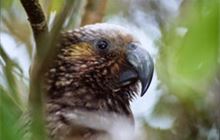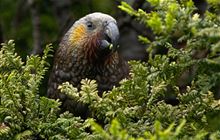Addressing concerns about 1080
Introduction
Aerially applied 1080 bait is a necessary and effective method for protecting native wildlife, but some people have concerns about its use.There’s a lot of misinformation out there about 1080. Below are some of the facts from decades of research so you can be confident that 1080 is being safely used to help protect our native wildlife.
What’s on this page
- Environmental effects
- Human health
- Drinking water
- Animal welfare
- Native and non-native animals
- History
- Support and regulation
- No alternatives
- Research and references
Environmental effects
1080 breaks down quickly and doesn’t build up in the environment or remain in the food chain. It is biodegraded or broken-down by microorganisms in the soil and it dilutes to harmless levels in waterways.
It also doesn’t build up in insects, aquatic life or plants, and it doesn’t damage the health-giving properties of plants or forests or make them unsafe.
Visit Why we use 1080 for more information.
Human health
There have been no recorded cases of aerial 1080 operations causing harm to human health.
The tight regulations around the use of 1080 mean that people should not come into contact with it and drinking water supplies are safe.
1080 is not a hormone or endocrine-disrupting chemical and is highly unlikely to cause cancer.
The same chemical that is in 1080 pellets to kill pests (fluoroacetate) is also found in tea and pūhā in tiny amounts. Some plants naturally produce this toxic chemical to prevent them from being eaten by animals.
Visit People, recreation and commercial activity for more information.
Drinking water
Drinking water in New Zealand has never been contaminated by a 1080 operation. There are rules and regulations to prevent this.
Decades of research and monitoring in water catchments treated with 1080 have shown that contamination is extremely unlikely when the current safety procedures are followed.
Public health requirements and operational practices also ensure that the use of 1080 does not have a negative impact on the water quality of streams or rivers.
Visit 1080 and drinking water for more information.
Ongoing water testing
More than 2000 samples of water used for human drinking supplies were tested between 1990 and 2023. Of these samples, only four of these contained traces of 1080 at concentrations of 0.1 to 0.2 ppb. These are low levels that are well below the Ministry of Health requirement and pose no risk to human health.
Animal welfare
"I don't get up in the morning excited to kill things, I get up in the morning excited to save species. We have a choice to make. You can choose stoats or kiwi, you can choose rats or pekapeka.
You can't have both, you just can't. And doing nothing is a choice in itself." DOC Ranger
Rats, stoats and possums are not native to New Zealand. They are introduced predators that kill an estimated 25 million native birds each year.
It’s our responsibility to protect native species - not introduced predators. Some 4000 native species are threatened or at risk of extinction.
We face a choice: leave pests unchecked and have silent, bare forests, or control predators and help native species to survive.
While we have clear goals to control and eradicate mammalian predators in New Zealand, we need to do this in a way that is as humane and effective as possible.
Choosing any tool for predator control raises ethical issues, and it’s understandable that some people may be concerned about controlling introduced predators with toxins.
As we make progress towards Predator Free 2050, the need for ongoing predator control will be reduced.
Visit Predator Free 2050 for more information.
Native and non-native animals
Native species
New Zealand is an unusual country in that, aside from bats, there are no native land mammals here. This means that 1080 can be used to control introduced predators without impacting most native species.
1080 is far less toxic to birds than mammals, but some of our native birds are susceptible to it, including weka, robins, tomtits, takahē and kea.
The following actions all reduce the risks to native birds:
- Applying less bait
- Dyeing pellets green making bait pellets less attractive to birds
- Adding cinnamon which attracts rats and possums but deters birds
Monitoring has shown that the small number of birds that are affected is outweighed by the population gains for their species and the benefits to ecosystems.
The breeding success and numbers of many native species increase significantly in areas where 1080 is regularly used to control predators.
Visit National Predator Control Programme Monitoring results for more information.
Did you know?
Only 5% of kiwi chicks make it to breeding age without predator control, but with effective predator control (including the use of 1080), up to 60% of chicks can survive to this age.
Fish and invertebrates
Studies show that 1080 has no detectable impact on invertebrate populations. 1080 in water does not affect the adults or larvae of insects such as caddisflies, mayflies and midges. Freshwater crayfish/kōura are also unaffected and safe to eat.
1080 in water also doesn’t affect native fish, including eels/tuna, or introduced trout, which are not attracted to 1080 pellets. Therefore, it is safe to eat fish from within predator control areas.
Visit 1080 and fishing for more information.
Game animals and hunting
Deer, goats, pigs and other introduced game animals are susceptible to 1080 poisoning, but 1080 is not used to control their populations.
We acknowledge the value of hunting in New Zealand, and work with hunting groups to understand the impacts of our predator control operations.
Following each operation, there is a caution period during which hunters are advised not to take meat from operational areas. However, there are always alternative areas of public conservation land open to hunters during that time.
Visit 1080 and hunting for more information.
Dogs
Dogs are highly susceptible to 1080 poisoning. When they eat bait pellets or the carcasses of poisoned rats, stoats or possums, the outcome is usually fatal.
Visit 1080 and dogs for information about the precautions we put in place and how dog owners can work with us to keep dogs safe during predator control operations.
Bees
The use of 1080 poses a very low risk to honeybees and honey products.
Where there is sufficient food available, honeybees from healthy, unstressed hives are unlikely to be attracted to 1080 bait pellets.
While it is very rare, honeybees might show an interest in 1080 bait pellets under certain conditions.
Visit 1080 and bees for more information.
The history of 1080 operations
Early predator control operations didn’t have access to the extensive research and technological advancements we have today.
Modern 1080 operations are much safer and more effective than they were in the past. Unfortunately, old stories from the 60s and 70s continue to circulate, creating a false picture of today’s conservation efforts.
In modern-day operations:
- we use cereal bait pellets that do not break up into small fragments
- bait pellets are dyed green and scented with a cinnamon lure to deter birds and attract possums and rats
- the quantity of bait has been reduced to just 1–3 kg per hectare for most operations – this is an average of 4–6 bait pellets applied in an area about the size of a tennis court
- helicopters use GPS technology to accurately distribute bait pellets, and flight paths are reviewed immediately after landing.
Did you know?
The above improvements, along with improved consultation with communities, has reduced the risk of poisoning in non-target species such as farm animals, dogs and native birds.
Support and regulation
Support for the use of 1080
The use of 1080 is supported through extensive research by independent scientists and other experts.
The Environmental Protection Authority has approved the use of 1080 as a tool for predator control in New Zealand.
All operations require permission from the Ministry of Health. We also consults and partners with the relevant rūnanga, hapū or iwi for each operation.
Many conservation groups and organisations support the use of 1080, including Forest & Bird, Federated Farmers, OSPRI, and the World Wildlife Foundation (WWF).
There is widespread support from community conservation groups because 1080 operations assist their conservation work.
Did you know?
In 2011, the independent Parliamentary Commissioner for the Environment conducted a review of the use of 1080. The report assessed 1080 for its effectiveness, safety and humaneness and found that not only should we continue to use 1080 to protect our forests, but we should use more of it.
Transparency and regulation
Several government agencies oversee the use of 1080 in New Zealand to ensure that it is safe and effective. There are regulations for health and safety, community consultation, animal welfare, bait manufacturing, and other practices.
Visit How we use 1080 for more information about regulation, engagement and monitoring.
No alternatives to 1080
There are no practical alternatives to 1080 for predator control over large landscapes and rugged terrain.
If we stop and wait for an alternative, progress will be lost. Some native species populations would become extinct in just two human generations. Overall forest health would decline.
Visit Predator Free 2050 Tools to Market Programme for information about how we're investing in new and existing pest management technology and methods.
Research and references
For more information visit Research and references. Or read our 1080 as a tool for predator control FAQ (PDF, 1,369K)




